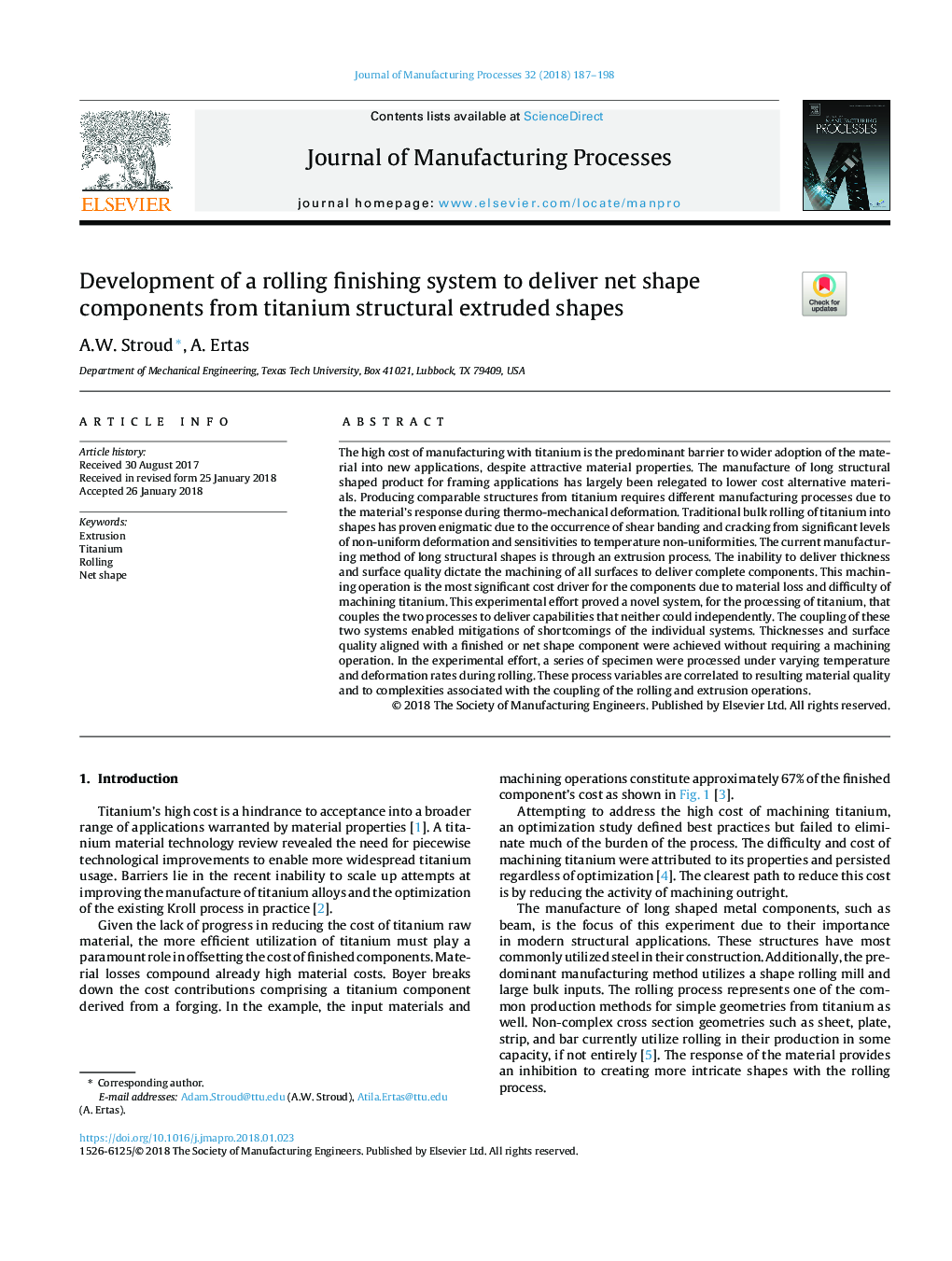| کد مقاله | کد نشریه | سال انتشار | مقاله انگلیسی | نسخه تمام متن |
|---|---|---|---|---|
| 8047953 | 1519224 | 2018 | 12 صفحه PDF | دانلود رایگان |
عنوان انگلیسی مقاله ISI
Development of a rolling finishing system to deliver net shape components from titanium structural extruded shapes
ترجمه فارسی عنوان
توسعه یک سیستم برش نورد برای ارائه اجزای خالص شکل از اشکال ساختاری تیتانیوم ساختاری
دانلود مقاله + سفارش ترجمه
دانلود مقاله ISI انگلیسی
رایگان برای ایرانیان
کلمات کلیدی
اکستروژن، تیتانیوم، رولینگ، شکل خالص
ترجمه چکیده
هزینه بالای تولید با تیتانیوم، مانع مهمی برای پذیرش گسترده مواد در برنامه های جدید، با وجود ویژگی های مواد جذاب است. تولید محصولات با طول عمر ساختاری برای طراحی فریم ها تا حد زیادی کاهش یافته است. ساخت سازه های قابل مقایسه از تیتانیوم نیاز به فرایندهای تولیدی مختلف به علت پاسخ ماده در طول تغییر شکل حرارتی مکانیکی. غلطک سنتی نورد تیتانیوم به شکل به دلیل وجود باند برشی و ترک خوردن از سطح قابل توجهی تغییر شکل غیر حساس و غیر حساس به درجه حرارت غیر یکنواخت ثابت شده است. روش تولید فعلی شکل های طولانی ساختاری از طریق فرایند اکستروژن است. ناتوانی در ارائه ضخامت و کیفیت سطح، ماشینکاری تمام سطوح را برای ارائه اجزای کامل هدایت می کند. این عملیات ماشینکاری، مهمترین ریسک هزینه برای اجزای به علت از دست دادن مواد و مشکل ماشینکاری تیتانیوم است. این تلاش تجربی یک سیستم جدید برای پردازش تیتانیوم را ثابت کرد که دو فرآیند را برای ارائه قابلیت هایی که به طور مستقل نمی تواند به هم متصل شود، متصل می کند. اتصال این دو سیستم باعث کاهش ریزپردازنده سیستم های فردی شد. ضخامت و کیفیت سطح هماهنگ با جزء به پایان رسید یا خالص بدون نیاز به عملیات ماشینکاری به دست آمد. در تلاش آزمایشی، یک سری نمونه تحت تغییر درجه حرارت و تغییر شکل در هنگام نورد پردازش شد. این متغیرهای فرایند با کیفیت مواد حاصل شده و پیچیدگی های مربوط به اتصال عملیات نورد و اکستروژن مرتبط است.
موضوعات مرتبط
مهندسی و علوم پایه
سایر رشته های مهندسی
مهندسی صنعتی و تولید
چکیده انگلیسی
The high cost of manufacturing with titanium is the predominant barrier to wider adoption of the material into new applications, despite attractive material properties. The manufacture of long structural shaped product for framing applications has largely been relegated to lower cost alternative materials. Producing comparable structures from titanium requires different manufacturing processes due to the material's response during thermo-mechanical deformation. Traditional bulk rolling of titanium into shapes has proven enigmatic due to the occurrence of shear banding and cracking from significant levels of non-uniform deformation and sensitivities to temperature non-uniformities. The current manufacturing method of long structural shapes is through an extrusion process. The inability to deliver thickness and surface quality dictate the machining of all surfaces to deliver complete components. This machining operation is the most significant cost driver for the components due to material loss and difficulty of machining titanium. This experimental effort proved a novel system, for the processing of titanium, that couples the two processes to deliver capabilities that neither could independently. The coupling of these two systems enabled mitigations of shortcomings of the individual systems. Thicknesses and surface quality aligned with a finished or net shape component were achieved without requiring a machining operation. In the experimental effort, a series of specimen were processed under varying temperature and deformation rates during rolling. These process variables are correlated to resulting material quality and to complexities associated with the coupling of the rolling and extrusion operations.
ناشر
Database: Elsevier - ScienceDirect (ساینس دایرکت)
Journal: Journal of Manufacturing Processes - Volume 32, April 2018, Pages 187-198
Journal: Journal of Manufacturing Processes - Volume 32, April 2018, Pages 187-198
نویسندگان
A.W. Stroud, A. Ertas,
